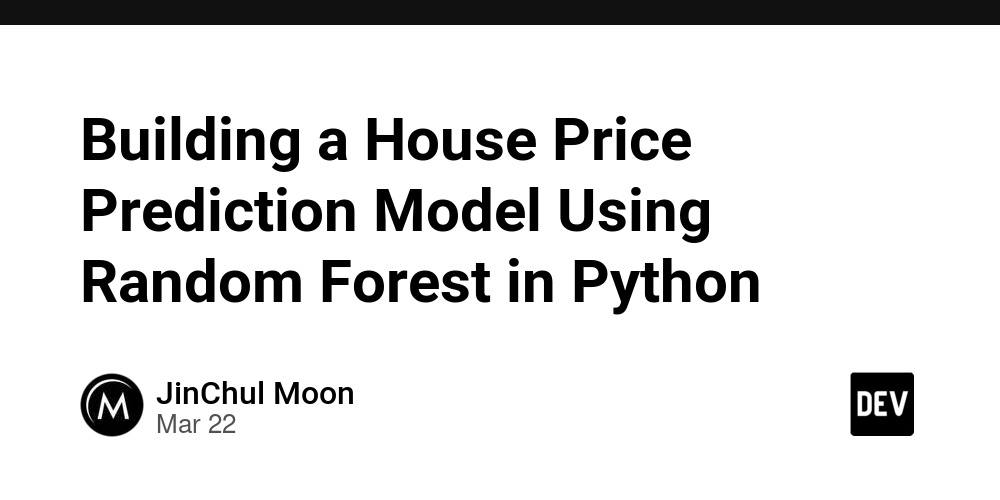Building a House Price Prediction Model Using Random Forest in Python
Today, I want to share my experience of building a House Price Prediction Model using the Random Forest algorithm in Python. This was an exciting project that gave me hands-on experience with Machine Learning and data analysis. Here’s a quick breakdown of how I approached the project: Data Collection and Preprocessing: I used a publicly available dataset of house prices. The dataset included various features like the number of rooms, location, and other house attributes. First, I cleaned and preprocessed the data by handling missing values and encoding categorical variables. import pandas as pd data = pd.read_csv('house_prices.csv') data.fillna(method='ffill', inplace=True) Feature Selection: I then selected the most relevant features for the prediction. I used correlation matrices and domain knowledge to choose which columns would help the model make accurate predictions. Model Training: I used the Random Forest Regressor from the Scikit-learn library. This model works well for regression tasks and can handle non-linear relationships between features. from sklearn.ensemble import RandomForestRegressor model = RandomForestRegressor(n_estimators=100, random_state=42) model.fit(X_train, y_train) Model Evaluation: After training the model, I evaluated its performance using metrics like Mean Squared Error (MSE) and R-squared to ensure the model was accurate enough for predictions. from sklearn.metrics import mean_squared_error, r2_score y_pred = model.predict(X_test) print(mean_squared_error(y_test, y_pred)) print(r2_score(y_test, y_pred)) Making Predictions: Once satisfied with the model’s performance, I used it to make predictions on new house data and see how well the model generalized to unseen data. new_data = pd.DataFrame({'rooms': [3], 'location': ['suburb'], 'size': [120]}) predicted_price = model.predict(new_data) print(predicted_price) This was a very practical and engaging project that allowed me to apply machine learning concepts in a real-world scenario. The model was able to predict house prices with a good degree of accuracy, and I learned a lot about data preprocessing, model evaluation, and the power of Random Forest for regression tasks. For a more detailed breakdown, including all code snippets and the dataset used, check out the full post at the link below: Building a House Price Prediction Model Using Random Forest in Python

Today, I want to share my experience of building a House Price Prediction Model using the Random Forest algorithm in Python. This was an exciting project that gave me hands-on experience with Machine Learning and data analysis. Here’s a quick breakdown of how I approached the project:
- Data Collection and Preprocessing: I used a publicly available dataset of house prices. The dataset included various features like the number of rooms, location, and other house attributes. First, I cleaned and preprocessed the data by handling missing values and encoding categorical variables.
import pandas as pd
data = pd.read_csv('house_prices.csv')
data.fillna(method='ffill', inplace=True)
Feature Selection: I then selected the most relevant features for the prediction. I used correlation matrices and domain knowledge to choose which columns would help the model make accurate predictions.
Model Training: I used the Random Forest Regressor from the Scikit-learn library. This model works well for regression tasks and can handle non-linear relationships between features.
from sklearn.ensemble import RandomForestRegressor
model = RandomForestRegressor(n_estimators=100, random_state=42)
model.fit(X_train, y_train)
- Model Evaluation: After training the model, I evaluated its performance using metrics like Mean Squared Error (MSE) and R-squared to ensure the model was accurate enough for predictions.
from sklearn.metrics import mean_squared_error, r2_score
y_pred = model.predict(X_test)
print(mean_squared_error(y_test, y_pred))
print(r2_score(y_test, y_pred))
- Making Predictions: Once satisfied with the model’s performance, I used it to make predictions on new house data and see how well the model generalized to unseen data.
new_data = pd.DataFrame({'rooms': [3], 'location': ['suburb'], 'size': [120]})
predicted_price = model.predict(new_data)
print(predicted_price)
This was a very practical and engaging project that allowed me to apply machine learning concepts in a real-world scenario. The model was able to predict house prices with a good degree of accuracy, and I learned a lot about data preprocessing, model evaluation, and the power of Random Forest for regression tasks.
For a more detailed breakdown, including all code snippets and the dataset used, check out the full post at the link below:
Building a House Price Prediction Model Using Random Forest in Python









































































































































































![[The AI Show Episode 142]: ChatGPT’s New Image Generator, Studio Ghibli Craze and Backlash, Gemini 2.5, OpenAI Academy, 4o Updates, Vibe Marketing & xAI Acquires X](https://www.marketingaiinstitute.com/hubfs/ep%20142%20cover.png)



























































































































![[FREE EBOOKS] The Kubernetes Bible, The Ultimate Linux Shell Scripting Guide & Four More Best Selling Titles](https://www.javacodegeeks.com/wp-content/uploads/2012/12/jcg-logo.jpg)



![From drop-out to software architect with Jason Lengstorf [Podcast #167]](https://cdn.hashnode.com/res/hashnode/image/upload/v1743796461357/f3d19cd7-e6f5-4d7c-8bfc-eb974bc8da68.png?#)






































































































.png?#)




.jpg?#)
































_Christophe_Coat_Alamy.jpg?#)








































































































![Rapidus in Talks With Apple as It Accelerates Toward 2nm Chip Production [Report]](https://www.iclarified.com/images/news/96937/96937/96937-640.jpg)








































































































































